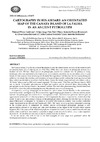Please use this identifier to cite or link to this item:
https://accedacris.ulpgc.es/jspui/handle/10553/69798
| DC Field | Value | Language |
|---|---|---|
| dc.contributor.author | Pérez Gutiérrez, Manuel | en_US |
| dc.contributor.author | Pais Pais, Felipe Jorge | en_US |
| dc.contributor.author | Perera Betancort, María Antonia | en_US |
| dc.contributor.author | González-García, A. César | en_US |
| dc.contributor.author | Cuenca Sanabria, Julio | en_US |
| dc.contributor.author | Belmonte, Juan Antonio | en_US |
| dc.date.accessioned | 2020-02-05T12:50:07Z | - |
| dc.date.available | 2020-02-05T12:50:07Z | - |
| dc.date.issued | 2018 | en_US |
| dc.identifier.issn | 1108-9628 | en_US |
| dc.identifier.other | Scopus | - |
| dc.identifier.uri | https://accedacris.ulpgc.es/handle/10553/69798 | - |
| dc.description.abstract | The Canary island of La Palma (ancient Benahoare) is one the richest island territory of the world in rock art manifestations (Martín Rodríguez and Pais Pais, 1996); there are dozens of petroglyph stations in a territory of only 700 km2. These groups of petroglyphs, carved in a delicate way by picking or lining techniques, often are representations of geometric forms (spirals, concentric circles, meanders, etc.) of great beauty. If their number were not enough to illustrate the importance that they had for the former aboriginal settlers of the island, the situation and orientation of some of them would confirm the ritual significance that these artistic manifestations must have had for them. Across the island, important rock art stations such as "El Verde" (discovered in 1982 and named originally "El Cementerio”, Pais Pais and Herrera García, 2007) can be found. A beautiful phenomenon of light and shadow can be observed there, illuminating the petroglyphs on site during sunset at the summer solstice. This and other phenomenology located elsewhere in the island show the close relationship between Benahoare‟s rock art and astronomy. An especially puzzling petroglyph can be found in a place named Monte Braulio on the westernmost coast of the island (see Figure 1 a). This is one of the biggest single glyphs found in La Palma and it is nearly isolated. The petroglyph was carved on an inconspicuous almost horizontal lava platform that occupies an approximate surface of 3 m2. Our hypothesis is that it represents the world known to the inhabitants of the island. A metric and morphologic analysis of the petroglyph allows stressing the idea that we are facing a map of Benahoare, as imagined in the mind of its ancient inhabitants in a similar way as other prehistoric „maps‟ discovered so far (Harley and Woodward, 1987). The „map‟, which is perfectly orientated according to the cardinal points, is completed by another smaller spiral-shaped petroglyph (perhaps a solar representation) located at the map‟s east side (and therefore on the region of the horizon where sunrise happens). Both the map and the additional glyph are composed of a set of grooves, small channels and cup-marks, which could have been used for sympathetic magic rituals in order to call for rain, a major important necessity for the islanders in a territory where fountains were nearly absent. If we are correct, this will be one of the best examples of emic maps ever produced before the development of modern cartography. | en_US |
| dc.language | eng | en_US |
| dc.relation.ispartof | Mediterranean Archaeology and Archaeometry | en_US |
| dc.source | Mediterranean Archaeology and Archaeometry [ISSN 1108-9628],v. 18 (4 Special issue), p. 71-79 | en_US |
| dc.subject | 550501 Arqueología | en_US |
| dc.subject | 550405 Prehistoria | en_US |
| dc.subject.other | Archeoastronomy | en_US |
| dc.subject.other | La Palma Island | en_US |
| dc.subject.other | Map | en_US |
| dc.subject.other | Prehistoric Cartography | en_US |
| dc.title | Cartography in benahoare: An orientated map of the canary island of la palma in an ancient petroglyph | en_US |
| dc.type | info:eu-repo/semantics/Article | en_US |
| dc.type | Article | en_US |
| dc.relation.conference | Joint Conference of 10th INSAP Conference / 11th Oxford Conference / 25th SEAC Conference - The Road to the Stars | |
| dc.identifier.doi | 10.5281/zenodo.1472273 | |
| dc.identifier.scopus | 85060483198 | - |
| dc.identifier.isi | 000460799300010 | |
| dc.contributor.authorscopusid | 57199717457 | - |
| dc.contributor.authorscopusid | 52164166200 | - |
| dc.contributor.authorscopusid | 57212485805 | - |
| dc.contributor.authorscopusid | 36348253200 | - |
| dc.contributor.authorscopusid | 57205526836 | - |
| dc.contributor.authorscopusid | 7005080487 | - |
| dc.description.lastpage | 79 | - |
| dc.identifier.issue | 4 Special issue | - |
| dc.description.firstpage | 71 | - |
| dc.relation.volume | 18 | - |
| dc.investigacion | Artes y Humanidades | en_US |
| dc.type2 | Artículo | en_US |
| dc.contributor.daisngid | 31463968 | |
| dc.contributor.daisngid | 29822719 | |
| dc.contributor.daisngid | 947752 | |
| dc.contributor.daisngid | 34951100 | |
| dc.contributor.daisngid | 29847145 | |
| dc.contributor.daisngid | 251899 | |
| dc.utils.revision | Sí | en_US |
| dc.contributor.wosstandard | WOS:Gutierrez, MP | |
| dc.contributor.wosstandard | WOS:Pais, FJP | |
| dc.contributor.wosstandard | WOS:Betancort, MAP | |
| dc.contributor.wosstandard | WOS:Gonzalez-Garcia, AC | |
| dc.contributor.wosstandard | WOS:Sanabria, JC | |
| dc.contributor.wosstandard | WOS:Belmonte, JA | |
| dc.date.coverdate | 2018 | |
| dc.identifier.conferenceid | events121145 | |
| dc.identifier.ulpgc | Sí | es |
| dc.description.sjr | 0,288 | |
| dc.description.sjrq | Q2 | |
| dc.description.ahci | AHCI | |
| dc.description.erihplus | ERIH PLUS | |
| item.grantfulltext | open | - |
| item.fulltext | Con texto completo | - |
| crisitem.event.eventsstartdate | 18-09-2017 | - |
| crisitem.event.eventsenddate | 22-09-2017 | - |
| Appears in Collections: | Artículos | |
Page view(s)
153
checked on May 17, 2025
Download(s)
90
checked on May 17, 2025
Google ScholarTM
Check
Altmetric
Share
Export metadata
Items in accedaCRIS are protected by copyright, with all rights reserved, unless otherwise indicated.
